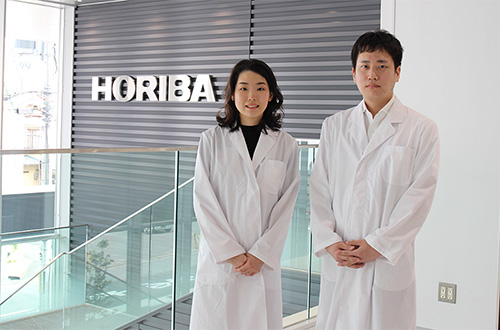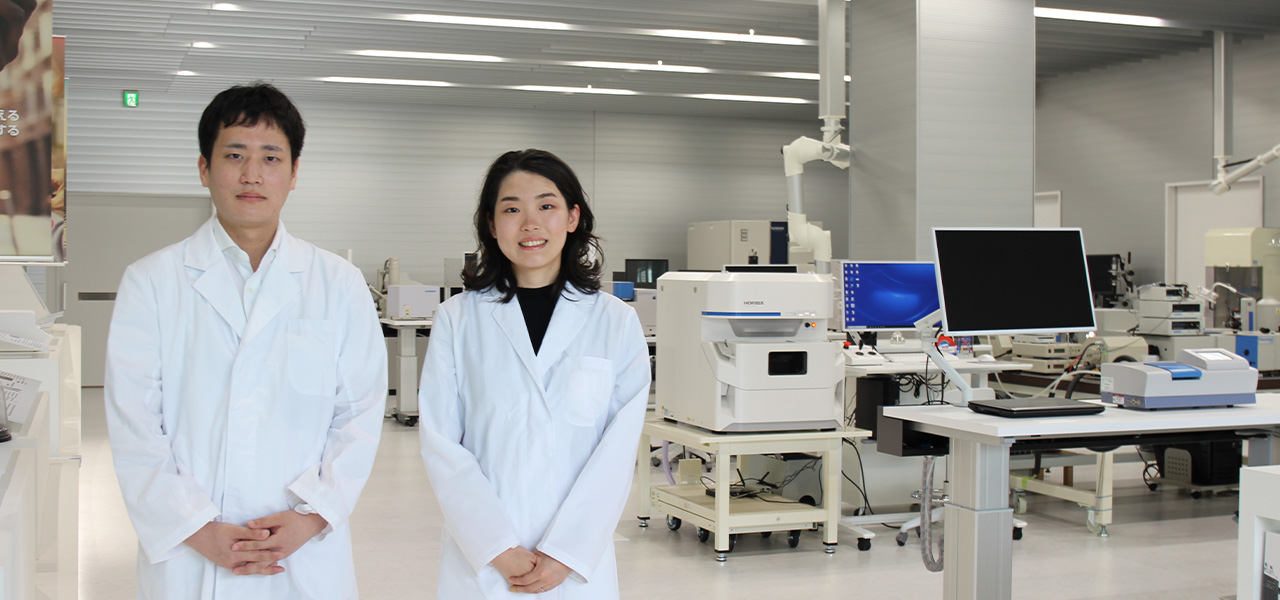
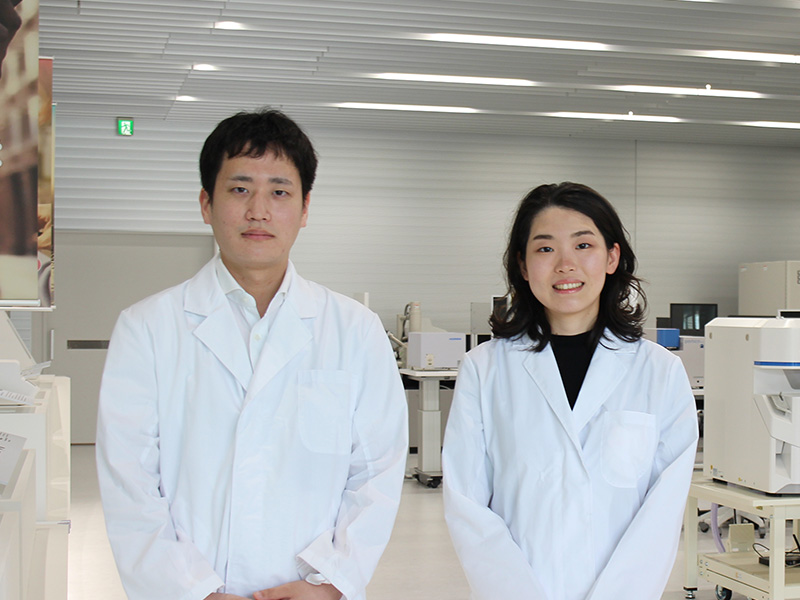
Special Interview Vol.3


Special Interview Vol.3
X-ray fluorescence analysis: Mayu Morita
Raman spectroscopy: Morihiko Onose
Analytical & Testing Technology Department, Analytical Technology Division, HORIBA TECHNO SERVICE / Chemical Analysis Team
The initial analysis of samples collected by Hayabusa2 from the asteroid “Ryugu” began in June 2021. In the third installment of our special interviews, we spoke with HORIBA Group analysis engineers Mayu Morita and Morihiko Onose, who engaged in nondestructive analysis as part of the Chemical Analysis Team led by Prof. Hisayoshi Yurimoto of Hokkaido University. We asked them about their work on the initial analysis and more generally about their thoughts as analysis engineers. (The interview was conducted in September 2021)
Morita:
In the winter of 2018, Dr. Izumi Nakai from the Tokyo University of Science and the Chemical Analysis Team were looking for a company manufacturing analytical measurement systems, which company is capable of analyzing the types and amounts of chemical elements contained in the Ryugu samples by X-ray fluorescence analysis.*1 At that time, nobody knew how much sample Hayabusa2 would bring back to Earth, but it was clear that there would only be a minute and precious quantity to work with. Since HORIBA’s X-ray fluorescence analyzers offer outstanding performance and show high precision in microanalysis, we proposed a new analysis method and a novel sample cell that enabled to take advantage of these strengths to effectively analyze tiny quantities. As a result of the proposal, I was appointed to the Chemical Analysis Team.
*1 X-ray fluorescence analysis: A method of analysis for determining the types and quantities of chemical elements present in a substance by irradiating it with X-rays and then capturing the resulting light emissions, known as “fluorescent X-rays,” which are unique to each element.
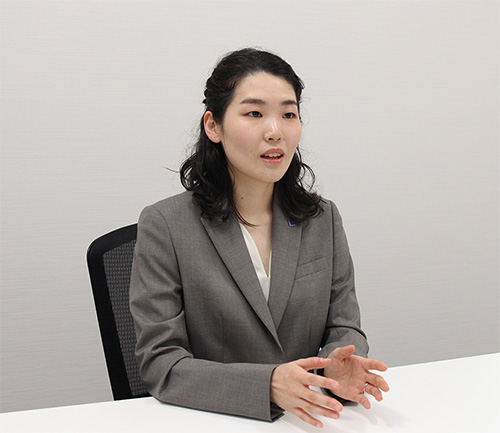
Morita:
The total quantity of sample brought back from Ryugu by Hayabusa2 was 5.4 g. However, there were several sets of samples distributed to each group for different purposes of analysis, the amounts of which varied from 1 mg to 25 mg. Although microanalysis is one of the strong points of the HORIBA X-ray fluorescence analyzer, we usually work with around 5 g to perform quantitative analysis for sandy samples. So, our first challenge was how to conduct precision measurements using only 1 mg samples. I started thinking about how much 1 mg is, and about what kind of substance the sand from Ryugu might be in.
In addition, it was necessary to protect the sample not only during the analysis but also the transportation. I have developed a special cell from scratch both to ensure improvements in quantitative accuracy even with different analyzers and to mitigate the risk of cross contamination. I have measured geological standards which were supposedly similar properties to the Ryugu sand many times. I continued working to improve the measurement method and special cell. At times I felt a little disheartened, particularly when things didn’t go as I hoped, but I just kept telling myself to “try again for one more day” and eventually things worked out. I was very happy when it was officially decided that we would work with the initial analysis team. Until then, I had always been thinking about Ryugu for a long time.
Onose:
The Chemical Analysis Team initially planned to use just X-ray fluorescence analysis for the chemical element analysis. But to investigate the composition more comprehensively, HORIBA proposed the additional use of Raman spectroscopy to Dr. Yurimoto. Around June 2020, I started an in-depth discussion on Raman spectroscopic analysis with Dr. Hiroharu Yui of the Tokyo University of Science. Then, in April 2021, it was decided that I would conduct a Raman analysis at the HORIBA Analytical Solution Plaza in Kyoto, where the X-ray fluorescence analysis was also set to happen. Although I had dreamed of doing such an analysis, I was surprised when the decision was made.
I also got involved with improving the special cell developed by HORIBA. My role was to feed back if we could measure samples smoothly by Raman spectrometers too. After the HORIBA analysis was completed, other members of the Chemical Analysis Team took over the analysis, so I continued working with the team and cooperating with HORIBA’s development and design people to improve the cell.
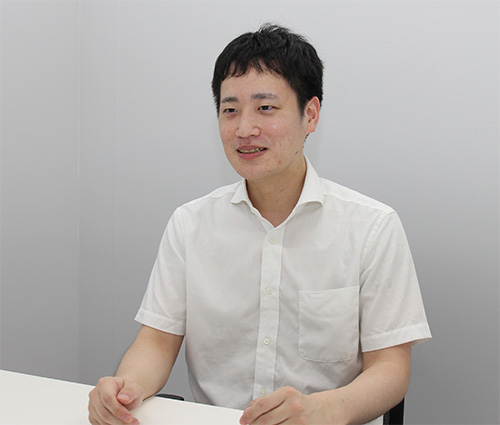
Morita:
Now I feel relieved as the analysis was successfully completed. In the initial analysis, a large number of people are analyzing the same samples, so we needed to make sure that the samples were not contaminated in any way. The pressure was very intense, but thankfully, we were able to pass the samples on for the next stage of analysis in good condition.
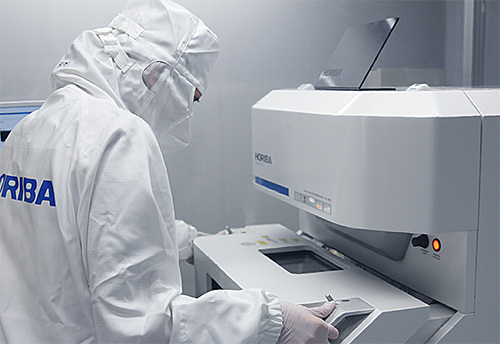
Qualitatively and quantitatively analyzing the chemical elements in the Ryugu sample using an X-ray fluorescence analyzer.
Onose:
Based on the X-ray fluorescence analysis results, we used a Raman spectrometer to analyze the components and structure of parts of samples that we wanted to examine in more detail. As a technique for microanalysis of minute quantities, Raman spectroscopy is even better than X-ray fluorescence analysis, so even 1 mg is relatively large enough. As Morita pointed out, the biggest difficulty was preventing contamination when handling samples.
One mystery I encountered was that in some cases Ryugu samples that showed the same physical structure under Raman spectrometry looked quite different under a microscope. I am looking forward to seeing the entire results of the initial analysis.
Onose:
The Chemical Analysis Team is performing a variety of analyses in addition to those conducted by HORIBA. Within the team we are verifying and discussing whether the results of different analysis methods are consistent with each other. Initial analysis will continue until June 2022, so I will be doing my best to help make the analysis data as scientifically valuable as possible.
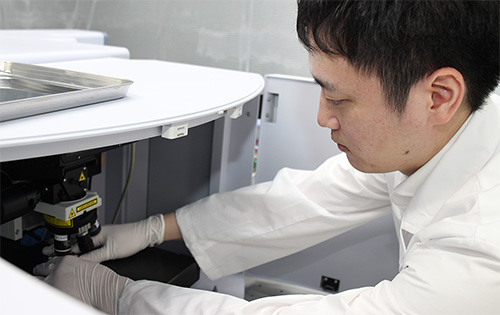
Raman spectroscopic analysis identifies mineral types based on differences in molecular structure.
Morita:
My routine tasks are to provide product demonstrations to customers who are considering purchasing HORIBA products, and to provide contract analysis services such as analyzing samples sent by customers and offering data. Clients send us test samples, and we discuss results together. Onose typically analyzes semiconductor and battery-related materials, and cosmetics to support the clients' R&D, whereas I do various kinds of samples to support their quality control, including food products and automotive parts. We both have one thought in common: Our goal is to support client companies with our solutions.
Morita:
When I was a little kid, I was a curious and asked a lot of questions.
The reason why I have pursued my career in natural science is that my math teacher at my high school was very inspiring. When solving a problem on an exam, he would always start by defining the terms or proving a theorem. When I asked him, “Do I need to do such unnecessary things too?”, he answered looking seriously, “Absolutely, yes. While you have not proved it yourself, how come you use it on your answer? Prove it by yourself. Then, you must question even obvious things.” Since then, I have wanted to investigate things with my own eyes, not merely questioning, and this spirit has led me to study science. Whenever I run into a problem that I need to struggle with, I remember what my math teacher taught me. I start by breaking it down into problems, define each problem in my mind and prove them. I still make use of this approach into my daily work.
At graduate school, I majored in molecular biology. Molecular biology often involves relatively qualitative evaluations, but as I did more and more research, I felt an urge to do more quantitative measurement. That feeling drove me to work at HORIBA. The fact that it is a global company is also a reason why I chose HORIBA.
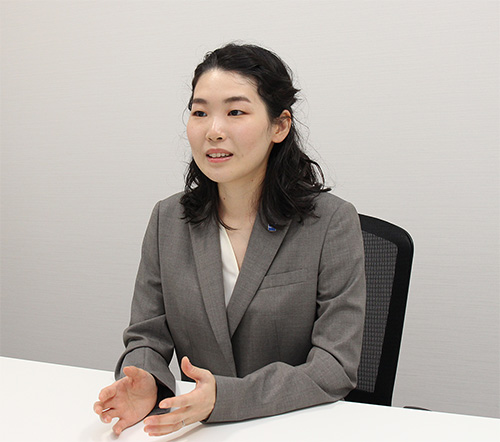
Onose:
I have been interested in living things since I was a child, so I wanted to pursue science. I spent a lot of time hunting bugs with my friends. At high school, I especially liked chemistry. I enjoyed learning how things that I had puzzled over really worked and the logical reasons why certain phenomena occurred. At university, I studied structural changes in proteins using diffraction gratings. I joined HORIBA because I wanted to work for a manufacturer of analytical equipment based on light, which is a subject central to my field of specialization at university.
Onose:
I believe analysis is very important for R&D. During my time at university, I actually had experience in building an analyzer to further my research. Referring to some literature, I assembled a light source, detector, and other components, but it was a time-consuming and difficult process. Through that experience, I felt like doing something to help ensure that R&D does not have to be disrupted or slowed down due to a lack of analysis equipment or an inability to handle such equipment. I also wanted to help create opportunities for more people to get access to analysis data.
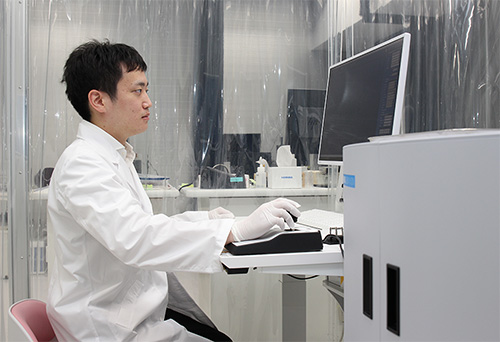
Morita:
In the field of analysis, we play the role of “analysis engineer.” At HORIBA, we compare analysis engineers to Formula 1 drivers. HORIBA analyzers are like racing cars, while the drivers who race the cars are the analysis engineers. A Formula 1 driver cannot win a race or dazzle people with their driving skills without understanding the characteristics and principles of the car nor knowing how to drive it well. In a similar way, I believe it is important for us to make the most of analytical equipment, to produce excellent analysis results and to share them with their clients. Throughout this project, we started “the race” slowly and tentatively with the Ryugu samples, not knowing the race track, but in conclusion we always need to take the same approach; try the best with the HORIBA analyzer, investigate the sample thoroughly, and get closer to better analysis results. Together with the cooperation of the Chemical Analysis Team and our colleagues in R&D and Design Department, I think we successfully strived for a higher goal as a team.
Morita:
On behalf of all HORIBA employees, first and foremost, I would like to express my gratitude again for the precious opportunity of participating in the initial analysis. I also appreciate a number of people for the support and assistance that I received. Throughout this project, I learned a lot and received the guidance from Dr. Yurimoto and the other professors. And as we proceeded with the initial analysis, we also received heartwarming messages of support from people outside the company. These messages inspired us tremendously and helped us to complete our analysis fruitfully.
Onose:
My initial interest in science was sparked by my love of living creatures. This led me to becoming involved in various fields, including state-of-the-art materials and scientific research on the Ryugu asteroid samples. While doing analysis, I seek out answers to my own questions like “what is the structure of this area?”, and “why is it like that?”. That joyful feeling is similar to the satisfaction I felt at high school when I suddenly figured out the cause of some natural phenomenon that I had wondered about. It would be great if this project is able to inspire more people to become interested in science.
